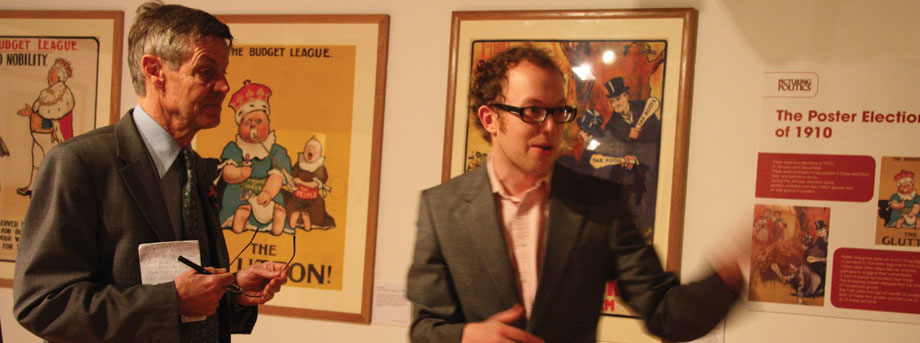The changing face of British politics
April 16th, 2012
A prestigious exhibition at the People’s History Museum in Manchester being curated by a politics student has attracted more than 26,000 visitors so far.
Picturing Politics: Exploring the Political Poster in Britain is curated by Chris Burgess, a third-year PhD student. He is researching the history of the British election poster as part of an ongoing collaboration between the People’s History Museum and The University of Nottingham and is funded by the Arts and Humanities Research Council.
Chris’s research — which looks at the changing face of election posters produced in Britain during the 20th Century — allows the exhibition to illustrate for the first time how some of these significant posters developed from the original concept of the party leader to the final image.
With more than 60 iconic examples of political posters, the exhibition — which runs until June 2012 — will explore the development of the poster and examine one of the key aspects of our democracy: how the way parties communicate with people has evolved over the years.
The popularity and prevalence of digital technology didn’t stop all the main political parties using posters to state their views on the NHS, unemployment, the economy, etc, during the 2010 General Election.
But digital technology allowed the general public to register their dissent with more than just a can of spray paint. While graffiti-covered billboards were a common sight during the election campaign, many people digitally manipulated the official posters to reflect their own stance and, in some cases, ridicule politicians. These doctored posters went viral via social networking sites, such as Facebook and Twitter, and, for many, became the definitive images of the 2010 election.
Opened by political commentator Matthew Parris, an MP from 1979 to 1986 before entering journalism, the exhibition displays the process of design, from initial idea, through preliminary artwork, to the final poster.
Thematic displays show how the treatment of some subjects has changed dramatically, for example, the depiction of women, while other subjects remain constant, such as representations of the party leader.
Visitors to the exhibition are encouraged to make up slogans and create their own posters.
Chris has featured on Radio 4 and has written a blog about his involvement in the exhibition: http://picturingpolitics.wordpress.com
He said: “My work on the exhibition has been very different from most academic work. Academics are more used to writing 10,000-word articles, whereas I’ve had about 100 words to comment on each poster.
“Some people say the poster is dead and political parties will stop producing them if they can be vandalised so easily but they have evolved and they still show how British politics uses them to create a link between images and words, it’s interaction with the public.”
Katy Archer, museum director, said: “The People’s History Museum is very proud to be able to show Picturing Politics. The exhibition is a fantastic collaboration between the museum and the University and Chris’s research has given us a valuable insight into our political poster collection.
“The exhibition is visually very strong and accessible for all our audiences and we are sure it will continue to be extremely popular.”
Credits: Chris Burgess/Matthew Parris image courtesy of People’s History Museum.
Tags: Arts and Humanities Research Council, Chris Burgess, Matthew Parris, People’s History Museum, Picturing Politics: Exploring the Political Poster in Britain
Comments are closed.
Other News

Need news? See you on SharePoint
After 14 years of service, Campus News is being retired as the university’s staff news platform. […]

Roads and car parks closed for refurbishing work
As part of ongoing road improvements at the university, works will be taking place to resurface […]


